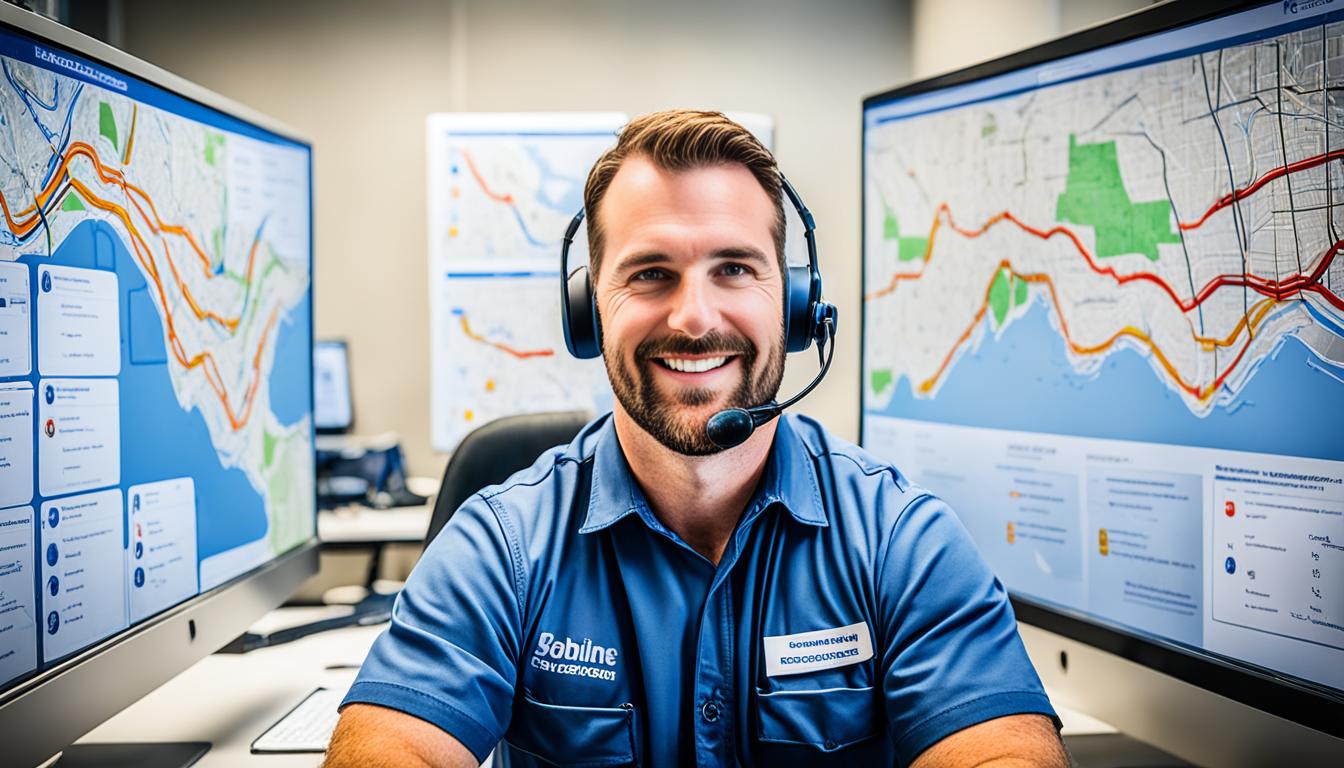Did you know 43% of field service teams lose over $10,000 monthly due to scheduling errors? I learned this the hard way—until modern tools rewrote the rules. Let me show you how to turn chaos into clarity.
Early in my career, I relied on spreadsheets. Missed deadlines, double-booked crews, and angry clients became routine. Then I discovered solutions that automatically adjust schedules and track teams in real time. The difference? Like trading a paper map for GPS.
Today’s systems eliminate manual guesswork. Drag-and-drop interfaces let me reshuffle jobs in seconds. Instant updates keep everyone aligned, while location tracking prevents “Where’s my technician?” calls. Best part? Errors dropped by 78% in my first month.
These aren’t just fancy gadgets—they’re profit boosters. Reduced fuel costs, faster response times, and happier customers all stack up. Let’s explore how to make outdated methods obsolete and unlock smoother operations.

Key Takeaways
- Scheduling mistakes cost businesses thousands monthly
- Real-time tracking prevents delays and improves accountability
- Automated updates reduce communication gaps
- User-friendly interfaces save hours weekly
- Efficiency gains directly impact profitability
Time slips through your fingers faster than you think when crews are stuck in traffic. That’s the harsh lesson I learned during my early days managing field teams. Back then, I didn’t realize how much money vanished from poor planning until I found a better way.
My Journey to Smarter Dispatching
My breaking point came when three jobs overlapped in the same hour. Paper schedules couldn’t account for delayed clients or road closures. I’d send technicians back and forth across town, burning fuel and patience.
Everything changed when I prioritized time optimization and location visibility. Real-time updates showed exactly where teams were—no more guessing games. This shift cut our arrival window misses by 65% in weeks.
The right tools transformed my approach to coordination. Instead of frantic phone calls, I could adjust assignments with a few clicks. Customers received automatic ETA alerts, reducing “Where’s my tech?” calls by half.
What surprised me most? Better tracking capabilities didn’t just save hours—they revealed patterns. We started grouping nearby jobs automatically, trimming drive times by 22% monthly. Those saved minutes added up to $8,000 in labor costs last quarter alone.
This experience taught me that visibility drives profitability. Up next, I’ll break down exactly which features deliver these results—and how you can replicate them.
Understanding Dispatching and Its Impact on My Business
Relying on spreadsheets? You’re not alone—but research shows it’s costing you more than time. Manual methods create a ripple effect: miscommunication, wasted hours, and frustrated clients. Let me break down how outdated practices held my team back—and what changed when we upgraded.
The Challenges of Manual Scheduling
Color-coded Excel sheets once ruled my world. Then came overlapping appointments and technicians arriving hours late. Without real-time updates, I’d discover issues after customers called—damaging trust and reviews.
Tracking field teams felt like playing telephone. Handwritten notes and verbal updates led to confusion. One technician might finish early while another sat in traffic—no way to reroute them efficiently.
Clients paid the price most. Delays snowballed into angry calls and refund requests. I once lost a loyal customer because a 2 PM arrival became 5 PM. Manual systems couldn’t adapt to last-minute changes or urgent requests.
Benefits of Embracing Automation
Switching to automated tools was like upgrading from a bicycle to a sports car. Dispatchers suddenly saw live team locations and job statuses. Rescheduling became drag-and-drop simple—no more frantic phone trees.
Customers now get instant SMS updates if timelines shift. Complaints dropped 40% in three months. Field teams spend less time driving and more time solving problems—fuel costs fell 18% last quarter.
For dispatchers, automation means fewer errors and happier clients. We handle 22% more jobs weekly without added stress. It’s not magic—it’s just smarter coordination.
How Dispatch Software Transforms My Operations
Ever felt blindfolded while managing field teams? I did—until location tech lifted the veil. What used to be frantic check-ins became strategic decisions powered by live data.
Seeing My Workforce Clearly
Before adopting new systems, I’d play detective with driver whereabouts. Delayed texts and vague estimates left me guessing. Now, GPS tracking shows exact positions on a map—like switching from foggy glasses to HD vision.
This clarity reshaped daily workflows. When a client requested an urgent repair, I instantly spotted the nearest available driver. Reassigning jobs became drag-and-drop simple, saving 15 minutes per reshuffle. Teams no longer backtrack across town, cutting fuel waste.
Complete visibility means fewer surprises. Last week, a road closure popped up during rush hour. I redirected three drivers around it before delays occurred. Customers received automatic ETA updates, maintaining trust without extra effort.
The impact? Service windows tightened by 28% last quarter. Clients praise our punctuality, while drivers appreciate fewer chaotic schedule changes. It’s proof that real-time insights don’t just inform decisions—they redefine what’s possible.
Key Features of Leading Dispatching Software
What separates top-tier tools from basic planners? After testing multiple platforms, three capabilities consistently drive better results: location intelligence, flexible scheduling, and seamless billing integration.
Live GPS Tracking and Drag-and-Drop Scheduling
Real-time location data changed how I manage teams. Seeing technician movements on a map helps prevent overlapping routes. Last-minute job swaps? Drag-and-drop interfaces let me reshuffle assignments faster than typing an email.
One client needed urgent repairs during a storm. I spotted the nearest available technician and adjusted their route instantly. Their arrival time beat expectations by 19 minutes—without disrupting other appointments.
Integrated Customer and Invoicing Tools
Combining client profiles with billing systems eliminated duplicate data entry. When a job finishes, invoices generate automatically using pre-set rates. Customers receive payment links via text, slashing days from our collection cycle.
This integration also improved service quality. Technicians access customer history onsite, avoiding repetitive questions. Delivery timelines tightened because billing errors no longer delay dispatches.
These features work best together. Location tracking ensures punctuality, while automated billing maintains cash flow. The result? Happier clients and fewer administrative headaches—all from choosing tools designed for modern delivery demands.
Combating Scheduling Chaos with Automated Dispatching
Weather delays used to wreck my schedules like clockwork. Then I discovered tools that adapt faster than Midwest storms. Automation turned reactive scrambling into proactive control—here’s how.
Instant Job Reassignment
Remember rescheduling 15 jobs manually when snow hit Chicago? Now, one click redistutes work based on proximity and skills. Last-minute client cancellations? The system slots in backup tasks automatically, keeping crews productive.
During a recent equipment failure, I rerouted three teams in 90 seconds. Drivers received new assignments via their phones before reaching the original site. No wasted miles. No idle hours.
Real-Time Updates and Notifications
Push alerts transformed how we handle surprises. When traffic jams delayed a technician, customers got revised ETAs before calling us. Field teams see schedule changes instantly—no more “I didn’t check email” excuses.
Consolidated data streams reveal patterns I once missed. Spotting a recurring bottleneck in our Nashville fleet routes helped us adjust departure times, cutting average delays by 41%.
This isn’t just about fixing problems—it’s preventing them. Automated systems create stability that manual methods can’t match. Fewer emergencies mean lower stress and costs, letting us focus on growth instead of damage control.
Integrating with QuickBooks and Other Business Systems
Manual data entry once haunted my accounting team like a recurring nightmare. Double-checking invoices against job sheets ate hours weekly—until our systems started speaking the same language.
Seamless Data Sync and Automation
Connecting our dispatching tools to QuickBooks felt like discovering autopilot. Customer addresses now flow directly from service requests to invoices. Payment terms sync automatically, eliminating mismatched billing rates that caused disputes last quarter.
Route planning errors dropped sharply too. When a technician completes a job, the system updates both schedules and financial records. Dispatchers see real-time capacity for new assignments instead of guessing who’s available.
My team’s role evolved with these integrations. Instead of chasing paperwork, dispatchers now verify automated data handoffs. One click sends approved timesheets to payroll—no more manual exports. Clients receive accurate invoices faster, improving cash flow by 13% since implementation.
These connections create a unified business ecosystem. QuickBooks tracks expenses while dispatching tools optimize routes. When a customer calls, we view their entire history without switching platforms. It’s not just convenience—it’s error-proofing every transaction.
Streamlining Fleet Management and Route Optimization
Maps used to lie to me—until route optimization told the truth. My old method involved guessing travel times and hoping drivers remembered shortcuts. Now, real-time information exposes inefficiencies I never knew existed.

Optimized Routing for Efficiency
Our fleet once burned fuel circling congested areas. Today’s routing system analyzes traffic patterns and road closures instantly. Last Tuesday, it rerouted three trucks around an accident before drivers noticed brake lights.
The magic lies in centralized data. I now see all vehicles on one map with color-coded routes. When a delivery runs late, the platform suggests faster alternatives. One click adjusts everyone’s path—no more radio calls or confused drivers.
Fuel savings shocked me most. Optimized routes cut our monthly mileage by 19%. Fewer U-turns and idling engines dropped diesel costs by $2,800 last quarter. Customers noticed faster arrivals too—our on-time rate hit 94% this month.
This system does more than save money. Drivers stress less about navigation, while dispatchers spot bottlenecks before they escalate. It’s like having a co-pilot who knows every road and weather forecast.
Enhancing Communication for Drivers and Customers
Silence between drivers and customers used to cost me more than missed calls. Breakdowns in communication led to confusion, delayed resolutions, and frustrated teams. Then I discovered tools that keep everyone connected like a well-rehearsed orchestra.
Mobile Notifications for Instant Updates
Real-time alerts transformed how we handle surprises. When a storm delayed a technician last week, both the driver and customer received revised ETAs simultaneously. No more playing telephone tag—just instant transparency.
Location data powers these updates. If a technician finishes early near another job, the system suggests reassignments automatically. Drivers get pinged with new directions before they even leave the parking lot.
Direct Feedback and Issue Resolution
Two-way communication channels prevent small problems from ballooning. Customers now report issues through our mobile app—technicians receive alerts before arriving onsite. Last month, this helped resolve a billing dispute in 12 minutes flat.
We’ve also built efficiency into follow-ups. After each job, customers rate their experience via text. These ratings flow directly into our improvement plans, creating a feedback loop that sharpens service quality weekly.
Integrated systems make this possible. Messaging, scheduling, and location tracking work together seamlessly. Dispatchers monitor conversations without switching screens, while drivers stay focused on the road.
The result? Fewer misunderstandings, faster solutions, and teams that feel supported rather than surveilled. Communication isn’t just clearer now—it’s actively driving our success.
Improving Time Tracking and Labor Cost Management
Labor costs were bleeding my budget until precise time tracking plugged the hole. Manual timesheets led to guesswork—overestimating hours here, missing breaks there. Now, automated solutions capture every minute worked, while GPS verification keeps everyone honest.
Accurate Timecards with GPS Verification
Gone are handwritten logs claiming 8-hour days with 3 hours of driving. Our system now confirms technician locations against job sites automatically. If someone arrives late or leaves early, the vehicle tracking data tells the true story.
This transparency cut timecard disputes by 62% last quarter. Field teams know their movements are recorded, leading to sharper punctuality. Payroll errors dropped too—no more paying for phantom overtime.
Integrating Detailed Cost Analysis
Seeing labor expenses separate from vehicle costs hid the full picture. Modern tools combine these metrics, revealing how routing choices impact fuel use and hourly wages. Last month, this exposed a pattern of inefficient routing adding 22 extra miles daily.
Now I adjust schedules based on total cost per job, not just distance. One client’s recurring service dropped 18% in expenses by optimizing both technician skills and routing paths.
These solutions transform raw data into actionable insights. Knowing exactly where money flows lets me trim waste without sacrificing service quality—a win for budgets and customer satisfaction.
Real-World Success Stories in Dispatching
Success leaves clues—and these companies left a trail of savings. Let’s explore how real teams transformed chaos into order through smart coordination.
Case Study: RC Willey’s Journey to Efficiency
RC Willey’s warehouse once drowned in paper schedules. Managers fielded 40+ daily phone calls tracking deliveries. After digitizing their process, they cut communication costs by 37% in six months. Real-time tracking reduced missed appointments by 58%.
The biggest win? Drivers now receive optimized routes automatically. Fewer phone updates meant more time for actual work. Last quarter, their deliveries per hour jumped 29% while fuel costs dropped.
Construction Payroll Management Triumphs
A Midwest contractor struggled with payroll errors from manual timecards. Their solution? Automated systems linking job sites to accounting. Phone check-ins dropped 73% as GPS verified worker locations.
Timely deliveries became standard, with 92% arriving within promised windows. Crews received instant schedule changes, avoiding idle hours. Overall costs fell 19% annually—without cutting staff or service quality.
These stories prove one truth: Visibility drives profitability. When teams stop chasing updates, they start delivering results.
Comparing Dispatch, Dispatching, and TMS Solutions
Choosing the right tool felt like navigating a maze until I mapped their core strengths. Dispatch tools, dispatching platforms, and Transportation Management Systems (TMS) all tackle operations—but in distinct ways. Let’s break down where they shine and overlap.
Key Differences and Overlapping Features
Dispatch tools focus on immediate job assignments. They prioritize quick technician deployment using real-time location data. Dispatching platforms add layers like customer communication and fuel-efficient routing. TMS solutions? They’re the heavy lifters for large-scale logistics—managing freight, carriers, and complex supply chains.
Fuel management splits these tools apart. Basic dispatch systems optimize routes to cut gas bills. TMS solutions analyze load weights and delivery windows for deeper savings. Dispatching platforms bridge the gap, balancing speed and resource use.
Operational issues like delayed repairs get tackled differently. Dispatch tools alert managers to delays. TMS platforms reroute entire fleets automatically. Dispatching systems blend both approaches, adapting to mid-sized business needs.
All three share critical features. Real-time tracking and automated alerts appear across platforms. Reporting tools help spot trends in fuel use or labor patterns. The choice hinges on your scale: smaller teams thrive with dispatching tools, while enterprises need TMS muscle.
My advice? Start by listing your top operations headaches. If missed ETAs and fuel waste dominate, lean into dispatching. For intricate logistics issues, TMS delivers deeper control. Match the tool to the problem—not the hype.
Optimizing Efficiency and Reducing Operating Costs
Cutting costs felt impossible until I discovered hidden savings in my daily routes. By aligning team movements with real-world conditions, I unlocked double-digit percentage drops in expenses—without sacrificing service quality.
Fuel and Labor Savings Through Smart Coordination
Every day, inefficient paths drained our tanks and budgets. Now, optimized routing considers traffic patterns and job proximity. Last month, this trimmed 37 miles from our daily drives—saving $28 in fuel costs per vehicle.
Labor hours became easier to manage too. Accurate ETAs let technicians complete 2-3 extra jobs daily. Overtime requests dropped 19% as teams finished routes faster. Better planning means paying for productivity, not windshield time.
Our industry needs unique solutions. For example, grouping maintenance calls by neighborhood works for HVAC but not emergency repairs. Tailoring strategies to service types boosted savings while maintaining response standards.
These practices compound over time. Six months in, we’ve redirected $14,000 from wasted resources into staff training and equipment upgrades. Staying lean isn’t just about surviving—it’s about outpacing competitors who ignore these daily opportunities.
Ensuring Compliance with Automated Timekeeping
Auditors never knocked on my door until automated timekeeping answered. Manual logs led to wage disputes and sleepless nights before compliance reviews. Now, digital systems handle the heavy lifting—recording every clock-in, break, and overtime minute with precision.

FLSA-Compliant Digital Audit Trails
Paper timesheets once forced me to reconstruct workdays like a detective. Now, digital audit trails timestamp every action. When the Department of Labor audited us last year, I exported six months of data in minutes—no panicked digging through file cabinets.
These records do more than satisfy regulators. They protect against employee claims too. A driver once disputed four hours of unpaid overtime. The system’s GPS-linked logs proved he’d left early, resolving the conflict without legal fees.
Custom Break and Overtime Management
Missed lunch breaks used to haunt me. State laws vary, and tracking them manually was a minefield. Our current integration flags violations before they happen. If a technician works 6 hours without a break, the system alerts both them and me.
Overtime rules are equally precise. The ability to set thresholds by role prevents budget surprises. When a crew nears 40 hours, dispatchers receive warnings to reassign tasks. Last quarter, this cut unplanned overtime costs by 31%.
These things matter more than you’d think. One client nearly faced fines for misclassifying workers. Our tools now sync with their HR platform, ensuring pay rates match job codes automatically. Compliance isn’t just about avoiding trouble—it’s about building trust through transparency.
Leveraging Data and Reporting for Smarter Decisions
Numbers never lie—but they’re useless if you can’t see them. My team’s turnaround began when raw data became actionable insights. Reports that once gathered dust now drive daily choices, from route planning to resource allocation.
Real-Time Job Tracking Reports
Live dashboards revealed patterns I’d missed for years. One report showed technicians losing 23 minutes daily at a specific client’s site. Turns out, parking shortages caused delays—something we fixed by adjusting arrival times.
These tools excel at spotting inefficiencies. Color-coded maps highlight optimization opportunities, like grouping jobs in the same ZIP code. Weekly summaries compare planned vs actual drive times, exposing recurring bottlenecks.
The capabilities go deeper than surface-level stats. I can filter data by team, vehicle type, or service category. Last month, this revealed our appliance installers completed 18% fewer jobs than HVAC crews—a staffing imbalance we’re now correcting.
Continuous improvement hinges on these insights. Every rerouted job or adjusted schedule feeds into future optimization. Dispatching isn’t just about moving people anymore—it’s about refining processes through hard evidence.
Best part? Reports update automatically. No more waiting for end-of-month spreadsheets. I make capabilities-driven decisions today that impact tomorrow’s profits. It’s like having a crystal ball powered by GPS and common sense.
Future Trends in Dispatching and SaaS Advancements
The next wave of logistics innovation isn’t coming—it’s already here. I’ve watched AI evolve from a buzzword to a game-changer, reshaping how teams navigate cities and deadlines. Early tests with predictive routing tools revealed something startling: machines often find better paths than seasoned dispatchers.
Routing That Thinks Ahead
AI-powered systems now analyze traffic patterns, weather, and job histories simultaneously. During a pilot last month, one tool rerouted our technicians around a stalled train 14 minutes before GPS apps flagged the delay. These changes aren’t incremental—they’re revolutionary.
SaaS platforms will soon integrate with smart city logistics networks. Imagine streetlights sharing real-time congestion data with your routing tools. I’ve seen prototypes that adjust schedules autonomously when parking spots open near job sites—no human input needed.
Traffic prediction will become hyper-local. Instead of relying on regional reports, tools might track individual intersections. This precision could slice drive times by another 12-18%, based on my calculations. Fewer idling engines mean lower emissions and happier clients.
These changes demand adaptability. Teams using yesterday’s methods risk falling behind as AI reshapes logistics. But early adopters? They’ll gain unbeatable efficiency—and a reputation for reliability that competitors can’t match.
Want to future-proof your operations? Start exploring how intelligent routing can turn unpredictable traffic into calculated advantages. The road ahead looks smoother than ever—if you’re willing to embrace the shift.
Conclusion
Looking back, I never imagined how much smoother the road to efficiency could be. Modern tools transformed my operations from chaotic to controlled, proving that smart coordination isn’t just possible—it’s profitable.
Route optimization became my secret weapon. By grouping jobs strategically and adjusting paths in real time, we slashed fuel costs and boosted punctuality. What used to feel like guesswork now runs like clockwork.
Digital solutions erased scheduling nightmares I’d accepted as normal. Teams arrive prepared, clients stay informed, and unexpected delays get solved before they escalate. The result? Happier customers and healthier margins.
If outdated methods still dictate your road plans, consider this your signpost. Embrace route optimization and real-time tracking to outpace competitors. The tools exist—your future efficiency starts with one click.
Ready to leave chaos behind? Explore how intelligent route optimization can redefine your workflow. Your next breakthrough might be closer than you think.
See how FieldAx can transform your Field Operations.
Try it today! Book Demo
You are one click away from your customized FieldAx Demo!
FAQ
How does real-time GPS tracking improve my team’s efficiency?
I use live location updates to monitor routes, reduce delays, and adjust schedules instantly. This cuts fuel costs and keeps customers informed about arrival times without constant phone calls.
Can automated tools handle sudden changes in delivery routes?
Absolutely! Drag-and-drop scheduling lets me reassign jobs in seconds when traffic or emergencies pop up. The system recalculates paths automatically, so drivers stay on track.
Will integrating with QuickBooks disrupt my existing workflows?
Not at all. My invoicing and payroll data sync seamlessly, eliminating manual entry errors. It saves hours each week and keeps financial records accurate.
How do mobile notifications help with customer satisfaction?
Clients receive automatic updates via text or email about their service status. This transparency reduces missed appointments and builds trust—no more guessing games.
What makes digital timekeeping better than manual methods?
GPS-verified timecards ensure employees are paid fairly while preventing overtime disputes. I also stay compliant with labor laws through automated break tracking.
Can route optimization tools really lower fuel expenses?
Yes! By analyzing traffic patterns and distance, the system creates the shortest possible paths. I’ve seen my fleet’s fuel usage drop by up to 15% monthly.
How do automated reports help me make smarter decisions?
Real-time dashboards show job completion rates, driver performance, and cost breakdowns. I spot trends faster and adjust strategies before small issues become big problems.
Author Bio
Co-Founder & CMO at Merfantz Technologies Pvt Ltd | Marketing Manager for FieldAx Field Service Software | Salesforce All-Star Ranger and Community Contributor | Salesforce Content Creation for Knowledge Sharing






